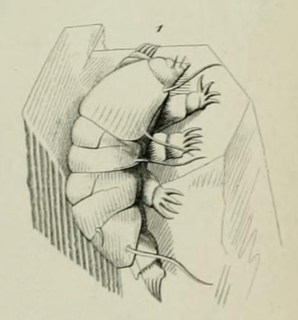
The saddleback toads are a genus of small, colourful toads the family Brachycephalidae in the order Anura. As traditionally defined, the family is often limited to just one genus, Brachycephalus, but it is closely related to Ischnocnema, which therefore is placed in the family in recent treatments. Brachycephalus species are tiny, often yellow frogs that are native to Atlantic Forest in southeastern Brazil. In at least one species, B. ephippium, the bright colours are aposematic, warning potential predators of its toxicity, specifically tetrodotoxin.

Conoidea is a superfamily of predatory sea snails, marine gastropod mollusks within the suborder Hypsogastropoda. This superfamily is a very large group of marine mollusks, estimated at about 340 recent valid genera and subgenera, and considered by one authority to contain 4,000 named living species.

Tardigrades, known colloquially as water bears or moss piglets, are a phylum of water-dwelling eight-legged segmented micro-animals. They were first described by the German zoologist Johann August Ephraim Goeze in 1773, who called them little water bears. In 1777, the Italian biologist Lazzaro Spallanzani named them Tardigrada, which means "slow steppers".

Hypsibius dujardini is a species of tardigrade in the class Eutardigrada. It is a tardigrade strain that is widely used for various research projects pertaining to evolutionary biology and astrobiology.
Crocidura phanluongi is a species of shrew in the genus Crocidura from southern Vietnam and nearby Cambodia. It is a somewhat small, gray shrew with an ecologically diverse distribution.

Echiniscus testudo is a cosmopolitan species of tardigrade.

Hypsibius is a genus of tardigrades in the class Eutardigrada.
The Micronoctuini are a tribe of moths in the family Erebidae that includes about 400 described species. Typical species in the tribe have bifine hindwing venation and are smaller than those in other noctuoid moths. Micronoctua karsholti is the smallest of all species in the superfamily Noctuoidea.

Milnesium tardigradum is a cosmopolitan species of tardigrades that can be found in a diverse range of environments. It has also been found in the sea around Antarctica. M. tardigradum was described by Doyère in 1840. It contains unidentified osmolytes that could potentially provide important information in the process of cryptobiosis.

Milnesium is a genus of tardigrades. It is rather common, being found in wide variety of habitats across the world. It has a fossil record extenting back to the Cretaceous, the oldest species found so far is known from Turonian stage deposits on the east coast of the United States.

Richtersius is a monospecific genus of tardigrades in the family Richtersiidae; its sole species is Richtersius coronifer. R. coronifer is one of two species of tardigrade that have been shown to survive and continue reproducing after exposure to outer space, specifically in the thermosphere at 258–281 km above sea level with ionizing solar and galactic cosmic radiation for 10 days. However, unlike Milnesium tardigradum, R. coronifer did not survive under these conditions plus UV exposure.

Milnesium berladnicorum is a species of Eutardigrade in the family Milnesiidae, native to Bârlad, Romania. Brownish in color, the species grows to a length of 400 micrometers. M. berladnicorum was named after the Berladnici, a tribe from Medieval Moldova.
Milnesium almatyense is a species of Eutardigrades in the family Milnesiidae. This species differs from its cogenerate species mainly by proportions of its claws and buccopharyngeal apparatus.
Milnesium asiaticum is a species of Eutardigrades in the family Milnesiidae. This species differs from its cogenerate species mainly by proportions of its claws and buccopharyngeal apparatus.
Milnesium reductum is a species of Eutardigrades in the family Milnesiidae. This species differs from its cogenerate species mainly by proportions of its claws and buccopharyngeal apparatus.
Milnesium longiungue is a species of Eutardigrades in the family Milnesiidae. This species differs from its cogenerate species mainly by proportions of its claws and buccopharyngeal apparatus.
Echinscus clavispinosus is a species of tardigrades in the family Echiniscidae. The species is endemic to the Cape Verde Islands and is found only in the island of Santo Antão. The species was first described by Paulo Fontoura, Giovanni Pilato and Oscar Lisi in 2011.
Echinscus azoricus is a species of tardigrades in the family Echiniscidae. The species is endemic to the Azores Islands. The species was first described by Paulo Fontoura, Giovanni Pilato and Oscar Lisi in 2008.

Hypsibius vaskelae is a species of tardigrade in the class Eutardigrada. The species was described from a freshwater sample near Saint Petersburg, Russia. It has wrinkled cuticle and cuticular bars between the bases of its claws on the first four legs. The species most closely resembles Hypsibius marcelli and Hypsibius septulatus, although has a wrinkled dorsal cuticle, thinner claws, and presence of lunules on the claws of all legs.









